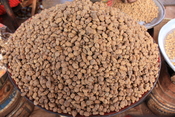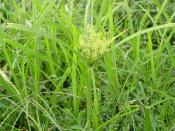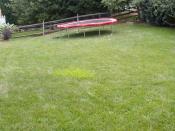Nutsedge: Weedy Pest or Crop of the Future?
Yellow nutsedge (Cyperus esculentus L.) is an invasive weed in the United States. It is often regarded as a useless pest to home gardeners as well as commercial growers. Along with being a useless weed it is difficult to control. Several commercial herbicides have been labeled for use exclusively on yellow nutsedge and are available at local retailers. This, of course, indicates much research has gone into the development of chemicals to eradicate it. In a country that spends much of it's time and money on programs focusing on the advancement of crop production has the yellow nutsedge been labeled unfairly? Could the U.S. find use for Cyperus esculentus L.? A look into it's past and present might reveal a profitable future.
Cyperus esculentus is in the order Commelinales and the family Cyperaceae. Cyperus esculentus can be distinguished from other species of New World nutsedge by its persistent linear brown spiklets that have closely appressed overlapping scales.
This perennial plant is self-incompatible. The stem of yellow nutsedge is triangularand has a light green-yellow color. Rhizomes that terminate in tubers are the main means of reproduction, although it does produce viable seed.
It is interesting to note that the name Linnaeus chose for this sedge, esculentus, means edible in latin (6). The two varieties of interest to us are Cyperus esculentus var. esculentus (weedy) and Cyperus esculentus var. sativus (cultivated). Most literature uses the name Cyperus esculentus for both the weedy and the useful sedge.
The weedy variety esculentus produces many seeds although the cultivated variety sativus produces few. Yellow nutsedge (weedy) has been reported to produce 605 million seeds per hectare in Massachusetts (4). Both reproduce vegetatively in great numbers. Research indicates that a single nutsedge tuber can produce about 1900...


